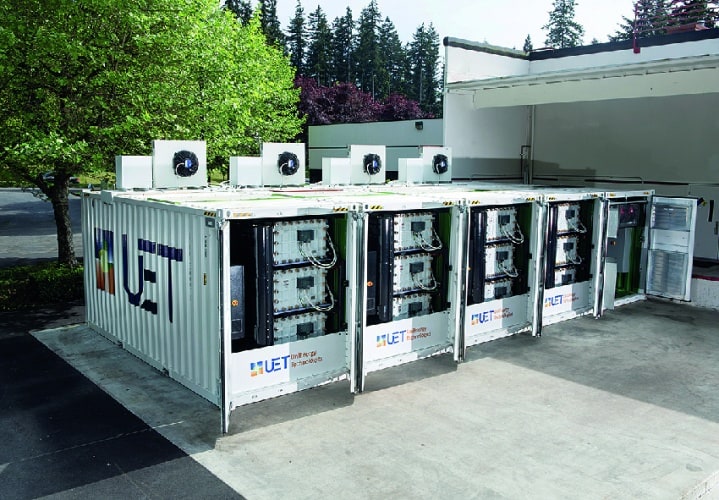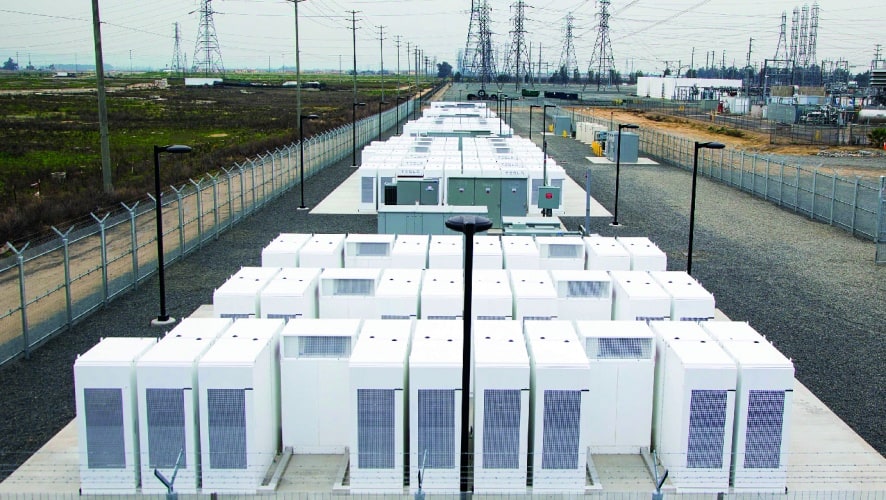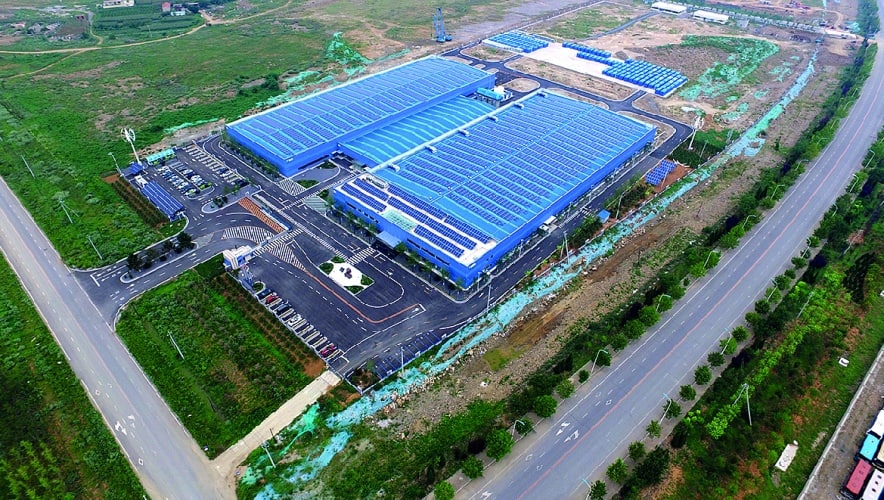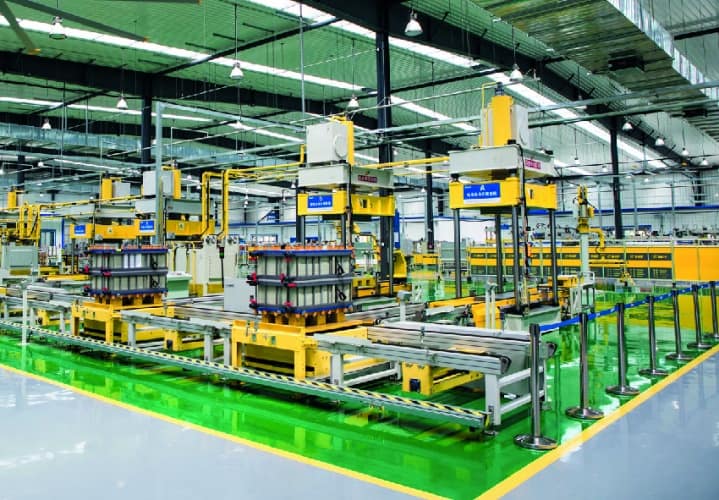
An energy storage installation from UniEnergy Technologies
Energy storage is often seen as the most important missing part in the electricity infrastructure of many countries, not least the UK. The main reason for this is renewable power. Wind, solar and marine energy (wave and tidal) have the potential to generate large amounts of electricity, but being dependent on natural processes they are not predictable and sometimes occur at periods diametrically opposed to when they are needed – for example, the sun shines during the day but we switch our lights on at night. Being able to store the energy in times of plenty – when it’s windy, sunny or the tide is coming in or going out – and then release it to the grid when it’s needed would allow renewables to be used to their full potential, and further reduce our reliance on fossil fuels.
There are many ways to store energy. Pumped storage, where water held in a reservoir at a high altitude is allowed to run through a turbine flowing down to a lower reservoir, is among the most reliable and is used in the UK, Scandinavia and elsewhere. Compressed air storage is also increasingly scrutinised, as is using surplus electricity to liquefy air so that it can be allowed to evaporate through a turbine (Highview Power, a pioneer in this field, is a previous winner of an Engineer award for innovation). The so-called hydrogen economy, where surplus electricity is used to electrolyse water, and the resulting hydrogen stored to be converted back into electricity through a fuel cell, has been touted as a solution for decades. All of these systems have been covered by The Engineer.
The technology that is currently receiving the most innovative engineering attention is, however, the energy storage solution that electrified the Industrial Revolution and one we have all been familiar with from our childhoods: batteries. But these are not Triple-As. They are large and highly sophisticated devices capable of holding very high amounts of charge and releasing them in the way that is required for the grid.
The workhorse for grid-scale storage today is the lithium-ion battery; not just the same battery technology that is used to power electric cars, but literally the same battery. The best known large-scale grid storage facility in the world, built by Tesla in South Australia, is known simply as the Big Battery. This consists of a very large array of Tesla’s Powerwall units, based on the same type of battery that powers Tesla’s cars.
Properly known as the Hornsdale Power Reserve, it is rated at 100MW/129MWh and stores wind energy from the adjacent Hornsdale wind farm and solar energy from domestic photovoltaic panels across the state. According to Tesla, it stores enough energy to power more than 30,000 homes. “By allowing renewable energy to be dispatched during peak periods when the wind is not blowing and mitigating the need for expensive gas peaking generation, South Australian electricity prices will be both lowered and stabilised,” Tesla said

Tesla lithium-ion units at the Horsndale Power Reserve
Australian battery expansion
Elsewhere in Australia, in late March the Australian government announced that it would invest $25m (£13.5m), matching an investment from the State of Victoria, to fund large-scale grid-connected batteries, together providing 50MW of power and some 80MWh of energy storage. Both will be located near solar farms; one at Gannawarra, near Kerang, again using batteries supplied by Tesla, and one at Warrenheip, Ballarat, with batteries supplied by Fluence. “Both Victorian batteries will help demonstrate how large-scale batteries can provide different benefits to the electricity system, including improving grid stability and power quality, and how they can help integrate more variable renewable energy into the grid,” said the Australian Renewable Energy Agency.
But despite lithium-ion batteries being the current preferred option, according to Prof Clare Grey, a theoretical chemist and specialist in rechargeable battery chemistry at the University of Cambridge, they are not necessarily the best option for this application. “Lithium-ion is good for short-term storage,” she said. “But how are you going to store energy for the weeks and months you might need if you went for an all-wind scenario? You either have absolutely massive storage facilities or you shunt electricity around over large distances, even between countries. The other issue is whether battery packs are going to last for long enough for the really big-scale applications. Lithium-ion batteries last on average two to seven years, but a lot of utility companies work in 20- to 40-year timescales. That’s a challenge, and although it’s grossly straightforward to change out a spent battery, it will come with a cost.”
Redox flow cells
Grey pinpoints other battery technologies such as sodium-ion as a drop-in replacement for lithium-ion, even being potentially cheaper, along with so-called “beyond lithium” solutions such as lithium-sulphur. But she sees the ultimate solution as a different type of battery known as a redox flow cell (sometimes known as a vanadium flow cell). These are, in essence, a type of fuel cell rather than a traditional electrochemical battery. “They are much larger-scale batteries where you have vats of liquids of oxidised and reduced chemicals and you flow them in and out to recover power whenever you need it. In principle, they are completely scalable, but just as expensive as lithium-ion, if not more so.”
This will not necessarily always be the case. Redox flow cells are more like process engineering equipment than Tesla’s solid-state batteries, consisting in part of components like tanks and pumps, which have benefited from economies of manufacturing scale. “We are waiting for the price to come down,” Grey explained.
Inside Rognke Power's vandium flow cell facility
But that hasn’t dissuaded China, one of the giants of the battery world. In Dalian, Rongke Power is operating a battery factory even larger than Elon Musk’s Gigafactory in Nevada, which produces Tesla’s batteries. Occupying an area larger than 20 football fields, the Rongke factory is producing components for what will take over from the Hornsdale Reserve as the world’s biggest battery: a 200MW, 800MWh facility serving China’s Liaoning province.
Writing in the American Institute of Electronic and Electrical Engineers journal, Spectrum, Z Gary Yang, who led a team at the Pacific Northwest National Laboratory in the US which developed vanadium flow cells in the early 2000s, explains the origins of the technology at NASA in the early 1970s. Yang describes it as a possible technology to power deep space missions where solar energy would not be available and with no need to store the hydrogen that powered the fuel cells of the Apollo missions – and so nearly caused disaster on Apollo 13. Evolving through research at the University of New South Wales, near considerable vanadium deposits, Yang’s team created a new type of redox flow cell with a vanadium-based electrolyte relying on reactions in a chloride solution which doubled the energy density of previous generations of cells, because more vanadium ions remained stable in solution and were available during charging and discharging. This is more advanced than the type being deployed by Rongke Energy.
Yang now runs a Washington State-based company named UniEnergy Technologies (UET), which specialises in megawatt-scale battery installations that fit inside a standard shipping container. “We’ve also brought down the batteries’ cost,” he said. “A few years ago, the cost of a four-hour VRFB [vanadium reflux flow battery] system was about $800 [£565] per kWh. These days, it’s about half that, comparable to the cost of a stationary lithium-ion system. But that’s not an apples-to-apples comparison. Lithium-ion’s capacity degrades over time, and its life span is shorter. We’ve tested individual VRFBs through more than 14,000 cycles, fully charging and discharging each cycle, and they still perform at 100 per cent capacity. This should translate into a life span of 20 years or more.”
Today’s technology
Of course, batteries are not the only thing that you need in a grid-scale electrochemical storage facility. Prof Richard McMahon, an expert in power electronics at Warwick Manufacturing Group, specialises in the additional equipment needed for such facilities and is not so focused on the battery chemistry as Clare Grey. “There’s a difference in perception between a research chemist and an applications engineer, which is me,” he said. “I look at what I can get now and what I’m likely to be able to get in the foreseeable future because that’s what I’ve got to do projects on. So I can perfectly understand that Clare comes from a more theoretical research standpoint, and can say that there could be better battery chemistries, and that may well be true and probably is, but I’m not going to see those battery chemistries as commercial batteries in, say, under 10 years. My projects are to put batteries into static energy storage working with my industrial partners; we are looking at what we can buy today. I’d be delighted if the theoretical or research chemists can produce some wonderful battery in five years that can outperform lithium.”
There are two important factors to consider when designing a facility, McMahon explained. These are the total amount of energy you want to store, which is measured in kilowatt or megawatt hours, and the other is how fast you need to push the energy out, measured in kilowatts, megawatts or gigawatts. The nature of the energy going into the system is much less important. “One of the very important grid services is a very fast frequency response when there’s an increasing load on the system or a dropout in other generating capacity. National Grid would like some power pretty quickly, fractions of a second – it might want 100MW in the next few milliseconds.”
The ancillary equipment that is McMahon’s speciality varies according to what type of battery is being used. Lithium batteries, for example, need a battery management system to monitor the state of all the individual electrochemical cells in the battery. Electric vehicles are equipped with such systems, McMahon said, and static batteries need precisely the same monitoring. Moreover, he added, as batteries use direct current but the National Grid is alternating current, “a box of power electronics” is needed to convert DC to AC and vice versa.
In fact, with the increasing prevalence of DC electronics and equipment, McMahon believes that AC’s days might even be numbered. “We’ve started to see developments in the DC world. Solar generation, wind are all DC, and batteries of course are DC. At the top level we are also seeing DC gridlines like the one that comes from Scotland down to North Wales; the UK isn’t big enough really to have DC interconnectors, but of course we have the interconnectors to other countries: France, Holland, there is the Norway one in planning, and China’s got a lot of long-distance DC cables.”

The Dalian 'gigafactory'
DC microgrids, supplying for example a large supermarket, industrial facility, a group of up to 50 houses or university campus, are a distinct possibility, he added. However, when asked if he were designing a whole new city, whether he would build a DC grid from scratch, McMahon chuckled. “We are just so used to AC, we can get the equipment at Screwfix. You can buy consumer units with AC circuit protection for very little money – you can’t buy those for DC – so it’s a bit of a brave step.”
Optimistic investment
Profs Grey and McMahon are part of The Faraday Institution, an organisation set up in the wake of business secretary Greg Clark’s decision to identify energy storage as a key strategic strength for the UK that needs to be built up. The institution is part of a three-pronged initiative known as the Faraday battery challenge. Faraday Institution spokesman Matt Howard explained: “The idea was, can we identify that we have in the UK all the essential components, and can we maximise the opportunity space for making the UK a player on the world stage of batteries?”
In its initial phase, funded by a £42m grant, the institution is focusing on automotive batteries because of the strong UK automotive industry. “We have some of the best world-class researchers in the basic science here, and we have government interest in innovation and cleaner air, and there’s an opportunity to maximise all this now. And there is some urgency because I think the government has recognised the world is racing forward and we can be part of that solution,” Howard said.
The institution’s research projects will last for three years in the first phase, then this will be followed by a series of regional workshops to identify the top challenges in each area. Howard acknowledges that the UK has had a spotty history with battery development: for example, lithium-ion batteries were originally invented in Oxford, but some years ahead of the development of camcorders and mobile phones, by which time the batteries were commercialised in East Asia and the US.
But it would be wrong to see the Faraday Institution as an attempt to correct that. “I see it as a much more optimistic investment, as opposed to trying to reclaim a historic loss,” Howard said.











IET sounds warning on AI doll trend
I agree that we need to reduce cooling water demand for servers. And yes, generative AI consumes a large amount. But what about BitCoins? Their...